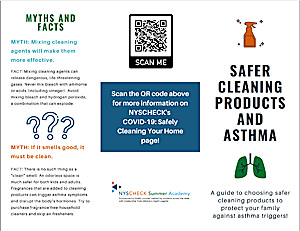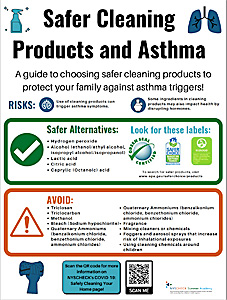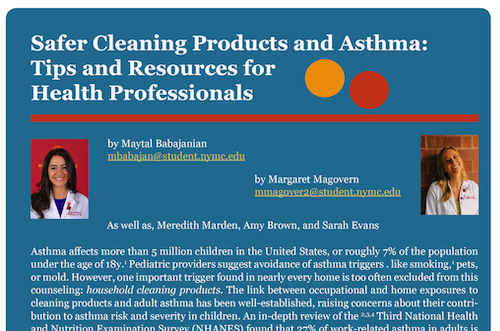The COVID-19 era has meant more time at home.
Although time outdoors is generally considered safe with proper masking and physical distancing, the home environment has become a more prominent part of our lives.
Adequate ventilation, wearing a mask, physical distancing, and vaccination are highly protective against infection.
For households with confirmed or possible COVID-19 cases, more extensive disinfection and additional precautions may be protective.
Clean and disinfect safely with these best practices
- Cleaning: removes germs, dirt, and grime from household surfaces. Cleaning does not kill germs, but removes some of them.
- Sanitizing: lowers the number of germs on a surface to a level deemed safe by public health organizations. This can include either cleaning or disinfecting.
Disinfecting: kills germs on surfaces after a surface is cleaned by using a disinfecting cleaning product.
Current evidence strongly indicates COVID-19 is transmitted through the air; there is a much lower risk of infection from touching surfaces. Cleaning surfaces does not take the place of physical distancing, wearing a mask, adequate ventilation and vaccination. However, if a household has a known or suspected case of COVID-19, or if there is an especially vulnerable person living in the home, surface cleaning may provide extra protection.
Chemical disinfectants like hydrogen peroxide, diluted bleach, or another EPA-certified disinfectant are effective against the coronavirus.
Choose products that contain safer active ingredients like hydrogen peroxide, ethanol, or citric acid, and avoid those with quaternary ammoniums (Quats) like benzalkonium chloride and ammonium chloride.
Disinfectants must be used correctly, safely, and according to manufacturer’s instructions to avoid harm to health. Open windows for fresh air. Keep children out of the area- children with asthma are especially sensitive to bleach, Quats, and other strong chemicals.
Remember to securely store all cleaning products (and other chemicals) out of the reach of children.
Hydrogen Peroxide
- Selecting hydrogen peroxide: Over-the-counter hydrogen peroxide (3%) can be used for general household cleaning.
- Use it safely: Pour a small amount of peroxide solution into a spray bottle, and apply carefully to surfaces. Let sit for at least 6 minutes. After, wipe off with a cleaning towel. Store-bought cleaners with hydrogen peroxide as the active ingredient should be used as directed on the bottle.
- Store it properly: Hydrogen peroxide loses its strength quickly when exposed to air or sunlight. After opening, keep the unused peroxide in its original bottle and seal tightly
Diluted Household Bleach
- NEVER mix bleach and ammonia or any other cleanser – this can create toxic fumes.
- Safety: Wear gloves. Open windows for fresh air. Keep children out of the area. Children with asthma may be particularly sensitive to bleach and other strong odors.
- Selecting bleach: Common household or laundry bleach (5.25% or 6%) bleach should be used. Do not use industrial strength bleach.
- Dilute it carefully: Use a funnel to carefully dilute the bleach with cool water. Always ensure to make a fresh batch as it can lose its strength overtime.
Large batch:
|
Small batch:
|
|---|
- Before disinfecting with bleach: clean surfaces with soap + water, then wipe dry.
- Apply diluted bleach safely: disinfect by carefully applying to the surface until glistening wet. If using a spray bottle, make sure it is on the “stream” setting (avoid using “mist” settings).
- Disinfecting time: Allow surfaces to completely dry (or wipe down with a paper towel after letting it sit for 5 to 10 minutes).
Disinfectant Wipes
- While disinfectant wipes are a fast and convenient tool for cleaning, some are safer than others. When possible, choose wipes that contain hydrogen peroxide, ethanol, or isopropyl alcohol, and avoid those with Quats like benzalkonium chloride and ammonium chloride.
- Safety: Open windows for fresh air. Gloves are generally unnecessary, unless you are using hospital-strength wipes. Keep children out of the area. Children with asthma may be particularly sensitive to bleach and other strong odors.
- Not all Clorox wipes are created equal: Take note of the strength of the product you are purchasing. There is no need to use hospital-strength wipes in the home, and doing so may actually be harmful for families (these products are commonly labeled as “hospital-grade,” “healthcare-grade,” or “ultra”).
- Where to use wipes: Wipes work best on solid surfaces; look to other methods of cleaning for fabrics or other materials.While many wipes are safe to use in kitchens, they should not come in direct contact with food or utensils.
- Use wipes correctly: Wipe the surface to be disinfected, ensuring enough product is applied to give the surface a wet appearance. Let it dry. Check the label and follow recommendations for the amount of time you should let it sit before touching or using.
Isopropyl Alcohol
- An undiluted isopropyl alcohol solution (at least 70% strength) can be used as disinfectant. These can be found over the counter.
- Safety: Open windows for fresh air. Keep children out of the area. Children with asthma may be particularly sensitive to bleach and other strong odors. Store safely, out of the reach of children. Make sure to keep away flame, heat or sparks when using.
- Where to use wipes: Isopropyl alcohol is most effective on hard surfaces.
- Use it correctly: Prep the surface by cleaning it with water and detergent. Apply the isopropyl alcohol and let sit for at least 30 seconds.
- Can alcohol-based hand sanitizer be used as a household disinfectant? Hand sanitizers are not meant to be used for disinfecting. If possible, stick to products specifically designed for disinfecting surfaces in your home.
Resource Links for more information on safe and effective household disinfection for COVID-19:
- Not sure if your household disinfectant will work against coronavirus? Check the EPA-certified disinfectants database for certified disinfectants.
- Centers for Disease Control and Prevention (CDC): Clean and Disinfect Coronavirus
- American Academy of Pediatrics (AAP): Cleaners, Sanitizers, and Disinfectants
Adequate ventilation, wearing a mask, physical distancing and getting vaccinated are the most effective ways of protecting yourself from COVID-19 infection. Hand-washing provides extra protection against coronaviruses and other infectious diseases.
Regular soap and water will work well to prevent the spread of germs. Remember to rub and scrub all hand surfaces for at least 20 seconds.
If soap and water are not available, use an alcohol-based sanitizer to kill germs. This should be used safely and stored out of the reach of children.
The CDC recommends products with at least 60% ethanol or 70% isopropyl alcohol. Do not attempt to make your own hand sanitizer at home- it can be harmful if not made correctly or it may be ineffective (unable to kill coronavirus).
First, ensure that hands are not greasy or dirty. If they are, wash with soap and warm water (if available).
Apply hand sanitizer to the palm of one hand and rub it on both hands and between fingers until dry. Use enough to cover all sides of both hands.
Frequent hand washing can lead to dry hands. If needed, use a fragrance-free lotion.
What are some simple steps to keep my home healthy?
A healthy home environment does not have to be difficult or expensive. Try these simple steps.
What are safe and healthy ways to do routine household cleaning?
Routine cleaning can reduce dust, allergens, and chemicals in your home. When cleaning, use safer products, which are better for your health and the environment.
Learn more about green cleaning options, including some easy do-it-yourself cleaning recipes made from common household ingredients- Rx for Prevention: Green Cleaning
How can I prevent or reduce harmful environmental issues in my home?
Here are some important steps to improve the quality of the air inside your home- Rx for Prevention: Indoor Air Quality
My child has asthma and is now spending most of their time inside my home. How can I reduce common asthma triggers in my home safely and effectively?
Don’t Smoke: Smoke from the end of a burning cigarette, cigar, or pipe contains a mixture of chemicals that can make asthma worse. These chemicals can persist in the environment and remain on surfaces, clothing, and skin. Rx for Prevention: Secondhand Smoke (español)
Make your home and car smoke-free. If you smoke, go outside to smoke and consider quitting. Learn more about secondhand and thirdhand smoke from the American Academy of Pediatrics.
Prevent Mold Growth: Mold can grow in areas of high humidity or water damage and can lead to allergy and asthma symptoms. Take steps to address mold- Rx for Prevention: Mold (español)
Keep Pests Out: Pests like cockroaches and mice are common and can trigger allergies and asthma. Using safe methods to prevent and get rid of pests are important. Eliminating the use of chemical pesticides is one important step.- Rx for Prevention: Pests and Pesticides (español)
Use Cleaning Products Safely: Whether you need to do routine cleaning to remove dust and grime, or disinfect high-touch surfaces to kill coronavirus (and other germs), use safer products and practices! Remember to keep all cleaning products safely stored. When cleaning, keep kids out of the area, open the windows to ventilate with fresh air, and follow product instructions closely.
Does a family member have asthma? Learn more about reducing environmental asthma triggers on our Asthma topic page.
Related Topics:
Partner Resources
Safer Cleaning Products and Asthma Brochure
Safer Cleaning Products and Asthma Poster
Safer Cleaning Products and Asthma: Tips and Resources for Health Professionals – from the AAP Action Newsletter




